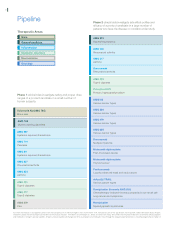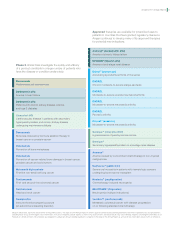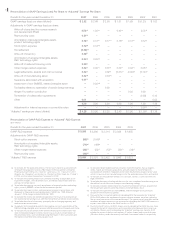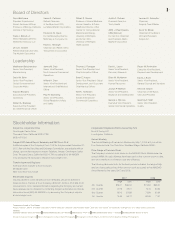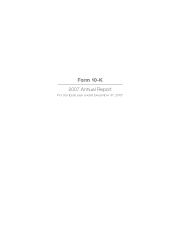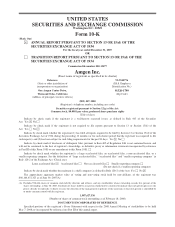Amgen 2007 Annual Report Download - page 16
Download and view the complete annual report
Please find page 16 of the 2007 Amgen annual report below. You can navigate through the pages in the report by either clicking on the pages listed below, or by using the keyword search tool below to find specific information within the annual report.have and will continue to materially adversely affect sales of our ESA products and, in particular, Aranesp®sales
in the U.S. supportive cancer care segment.
Throughout 2007, we had ongoing discussions with the FDA and other regulatory authorities regarding the
administration of our ESA products, which led to several key regulatory developments beginning with the FDA
approval, on March 9, 2007, of updated safety information for the class of ESAs, including Aranesp®and EP-
OGEN®, including a boxed warning in the prescribing information.
Additionally, during 2007, certain of the FDA’s advisory panels, including the Oncologic Drugs Advisory
Committee (“ODAC”), the Cardiovascular-Renal Drug Advisory Committee (“CRDAC”) and the Drug Safety
and Risk Management Advisory Committee (“DSaRMAC”) held meetings to discuss the safety/efficacy profile
of ESA use in certain settings. The ODAC is an advisory committee of external experts who advise the FDA
about the safety and efficacy of drug products for use in treating cancer patients. The CRDAC is an advisory
committee of external experts who advise the FDA about the safety and efficacy of drug products used in the
treatment of cardiovascular and renal disorders. The DSaRMAC is an advisory committee of external experts
who advise the FDA on, among other matters, risk management and communication. These committees are advi-
sory only and FDA officials are not bound to or limited by their recommendations. However, the FDA commonly
follows the recommendations of its advisory panels. On May 10, 2007, the ODAC held a panel meeting to dis-
cuss the safety/efficacy profile of ESAs in oncology. Responding to questions posed by the FDA, the ODAC
recommended that more restrictions be added to ESA labels and that additional clinical trials be conducted by
companies with currently approved ESAs, including us, although no specific restrictions or studies were recom-
mended at the ODAC meeting (see “Postmarketing and Safety Activities”). Further, on September 11, 2007, the
FDA held a joint meeting of the CRDAC and the DSaRMAC (referred to collectively as “CRDAC/DSaRMAC”),
which evaluated the safety data on ESA use in renal disease. The CRDAC/DSaRMAC recommended against re-
vising the ESA product labels to state that the target Hb level should not exceed 11 g/dL, recommended that the
ESA dosages used to achieve the Hb levels in the lower target groups in the Normal Hematocrit Cardiac Trial
and the CHOIR studies were sufficient to form the basis for ESA dosage recommendations and discussed poten-
tial clinical studies involving ESAs.
On November 8, 2007, in recognition of the input from the May 2007 ODAC and September 2007 joint
CRDAC/DSaRMAC meetings, we announced additional updates to the Aranesp®and EPOGEN®/PROCRIT®
package inserts in collaboration with the FDA and Johnson and Johnson Pharmaceutical Research & Develop-
ment (“J&JPRD”), a subsidiary of J&J. J&J markets recombinant human erythropoietin under the trademark
PROCRIT®in the United States (see “Joint Ventures and Business Relationships—Johnson & Johnson”). The
changes to the ESA labels included modifications to the boxed warnings, additional language in the IN-
DICATIONS AND USAGE section, and the WARNINGS section and clarification of the Hb range for CRF
patients was added in the DOSAGE AND ADMINISTRATION section. In addition, we discussed additional
clinical study concepts with the FDA to address potential safety concerns in patients with specific tumor types to
be added to our ongoing ESA pharmacovigilance program and are continuing to work with the FDA on this mat-
ter (see “Postmarketing and Safety Activities”).
We continue to work closely with the FDA to complete further labeling revisions to the class of ESAs, in-
cluding Aranesp®and EPOGEN®. We are in discussions with the FDA regarding safety data from the PREPARE
and GOG-191 studies including an updated box warning in the labeling information. These proposed labeling
changes were submitted under the regulatory mechanism known as a changes being effected (“CBE”) process.
We are also in discussions on proposed revisions to the labeling we submitted as part of our prior approval
supplement (“PAS”) in December 2007, that addressed questions raised during the May 10, 2007 ODAC meeting
regarding Hb initiation, Hb ceiling, discontinuance of ESA therapy after chemotherapy and data from additional
clinical studies. Additionally, the FDA has scheduled an ODAC meeting on March 13, 2008 as part of the FDA’s
ongoing pharmacovigilance review of ESAs.
On October 29, 2007, the European Agency for the Evaluation of Medicinal Products (“EMEA”) issued a
press release about upcoming changes to product information for ESAs stipulating a uniform target Hb range for
all ESAs of 10 g/dL to 12 g/dL with a warning not to exceed a concentration of 12 g/dL. We continue to be in
discussion with the EMEA to finalize updates to our ESA labels.
4


